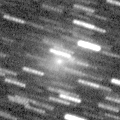
|
Brightened very rapidly. Now it is so bright as 8.7 mag (Apr. 5, Juan Jose Gonzalez). It approaches to the sun down to 0.88 A.U. in mid April, and it keeps 9-10 mag until mid May. It keeps observable until it fades out, although it keeps locating somewhat low in the morning sky. However, because it is a tiny comet, it may fade out very rapidly.
Date(TT) R.A. (2000) Decl. Delta r Elong. m1 Best Time(A, h)
Apr. 9 21 36.95 0 37.5 1.006 0.899 53 9.4 4:54 (247, 29)
Apr. 16 22 12.88 3 36.8 1.069 0.885 50 9.3 4:59 (245, 26)
|

|
Appearing in the morning sky in the Southern Hemisphere. Now it is 11.7 mag (Apr. 4, A. Novichonok and D. Chestnov). It is expected to keep so bright as 6-8 mag for a long time from 2011 to 2012, and to be observable in good condition in the Northern Hemisphere. In the Northern Hemisphere, it will be observable in late April.
Date(TT) R.A. (2000) Decl. Delta r Elong. m1 Best Time(A, h)
Apr. 9 22 48.29 -13 21.4 4.262 3.561 40 11.7 4:54 (271, 22)
Apr. 16 22 51.57 -12 15.8 4.112 3.493 46 11.5 4:59 (266, 28)
|

|
Now it is 14.1 mag (Mar. 11, A. Novichonok and D. Chestnov). It will be fading after this. The condition in this apparition is bad. It locates high in the Southern Hemisphere, however, it keeps extremely low until May in the Northern Hemisphere.
Date(TT) R.A. (2000) Decl. Delta r Elong. m1 Best Time(A, h)
Apr. 9 22 3.69 -18 51.3 2.148 1.733 52 13.6 4:54 (270, 34)
Apr. 16 22 20.24 -17 53.4 2.130 1.766 55 13.8 4:59 (266, 37)
|

|
Now it is 12.8 mag and visible visually (Apr. 1, Carlos Labordena). In the excellent sky condition, it was reported so bright as 11.2 mag with a very large diffuse coma up to 5 arcmin (Apr. 1, Juan Jose Gonzalez).
Date(TT) R.A. (2000) Decl. Delta r Elong. m1 Best Time(A, h)
Apr. 9 10 46.05 1 0.7 5.420 6.253 143 13.6 21:36 (180, 54)
Apr. 16 10 44.25 1 12.8 5.491 6.253 136 13.7 21:07 (180, 54)
|

|
Now it is very bright as 13.5 mag (Apr. 4, Tzec Maun Observatory). It will be 12 mag visually. It keeps bright as 13-14 mag for a long time after this until 2013. It is not observable in the Northern Hemisphere, but it is observable in good condition in the Southern Hemisphere.
Date(TT) R.A. (2000) Decl. Delta r Elong. m1 Best Time(A, h)
Apr. 9 16 18.16 -78 24.7 5.454 5.795 105 13.7 3:13 ( 0, 47)
Apr. 16 16 1.64 -79 47.7 5.390 5.778 107 13.7 2:30 ( 0, 45)
|

|
Big asteroid discovered in 1906. It suddenly showed the cometary activity on Dec. 11, probably due to an impact of a small object. It was very bright as 11.5 mag visually (Dec. 17, Juan Jose Gonzalez). It had a dust coma still on Jan. 9 (Joseph Brimacombe). Now it is stellar at 13.8 mag (Apr. 5, Juan Jose Gonzalez).
Date(TT) R.A. (2000) Decl. Delta r Elong. m1 Best Time(A, h)
Apr. 9 9 1.66 34 47.1 2.450 2.922 108 14.1 19:53 (180, 20)
Apr. 16 9 3.73 34 6.9 2.527 2.911 102 14.2 19:27 (180, 21)
|
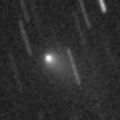
|
Now it is 14.3 mag, and already visible visually (Mar. 7, Juan Jose Gonzalez). It will brighten up to 12 mag in autumn. In the Northern Hemisphere, it keeps observable for a long time until 2012 spring. In the Southern Hemisphere, it is not observable until November. A small outburst occured and it brightened by 2 mag on 2010 Aug. 31 (Bernhard Haeusler). Recent brightening is somewhat slower than expected.
Date(TT) R.A. (2000) Decl. Delta r Elong. m1 Best Time(A, h)
Apr. 9 18 41.08 67 24.9 2.496 2.622 85 14.3 4:54 (184,-13)
Apr. 16 18 52.47 71 58.5 2.477 2.571 83 14.3 4:59 (181,-17)
|

|
First return of a new periodic comet which brightened up to 13 mag in a major outburst in 2005. Now it is appearing in the morning sky, and actually, it is unexpectedly bright as 14.3 mag (Apr. 5, Hidetaka Sato). It will be getting higher gradually after this, and will be observable in an excellent condition from summer to winter. It may be visible at 13 mag again. However, if it has just brightened temporarily in outburst, it may fade out very rapidly.
Date(TT) R.A. (2000) Decl. Delta r Elong. m1 Best Time(A, h)
Apr. 9 21 15.97 -19 25.4 2.439 2.179 63 14.6 4:54 (263, 44)
Apr. 16 21 29.20 -18 6.4 2.360 2.168 66 14.4 4:59 (258, 48)
|

|
It has been bright as 14.5 mag and visible visually already in last autumn (Sept. 30, Alan Hale). Appearing in the morning sky again. Now it is 15.1 mag (Mar. 30, Tzec Maun Observatory). It will be observable at 13-14 mag for a long time from 2011 to 2012.
Date(TT) R.A. (2000) Decl. Delta r Elong. m1 Best Time(A, h)
Apr. 9 20 29.92 -5 22.4 6.103 5.849 70 14.7 4:54 (238, 45)
Apr. 16 20 28.72 -5 11.6 5.956 5.824 77 14.6 4:59 (228, 50)
|
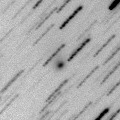
|
Now it is 13.3 mag, much brighter than originally expected and visible visually (Jan. 24, Juan Jose Gonzalez). In the Southern Hemisphere, it will be unobservable until late April. In the Northern Hemisphere, the altitude will be lower than 10 degree from February to April.
Date(TT) R.A. (2000) Decl. Delta r Elong. m1 Best Time(A, h)
Apr. 9 23 19.78 18 4.1 3.466 2.631 28 14.7 4:54 (249, -2)
Apr. 16 23 26.20 17 23.8 3.450 2.653 32 14.7 4:59 (246, 3)
|
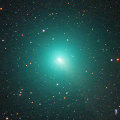
|
It approached to the earth down to 0.12 A.U. and brightened up to 4.6 mag in October (Oct. 18, Juan Jose Gonzalez). It was very large, double of the full moon, and very bright, visible with naked eyes. Now it is fading, but still visible visually at 13.6 mag (Mar. 29, Jakub Cerny). It will be getting lower after this, and will be unobservable in June.
Date(TT) R.A. (2000) Decl. Delta r Elong. m1 Best Time(A, h)
Apr. 9 7 57.97 4 10.6 1.796 2.225 101 15.2 19:08 (173, 51)
Apr. 16 8 6.97 4 38.0 1.932 2.285 97 15.5 18:59 (169, 50)
|
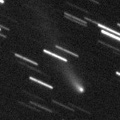
|
It reached up to 13.5 mag and visible visually in winter (Feb. 4, Juan Jose Gonzalez). Now it is fading, but still bright as 15.4 mag (Apr. 1, Hiroshi Abe). It will be unobservable soon in the Northern Hemisphere. In the Southern Hemisphere, it becomes low temporarily in May and June, but it keeps observable for a long time.
Date(TT) R.A. (2000) Decl. Delta r Elong. m1 Best Time(A, h)
Apr. 9 4 36.71 -18 7.0 3.425 3.004 57 15.5 19:08 ( 94, 39)
Apr. 16 4 39.85 -18 31.2 3.501 3.019 53 15.5 18:59 ( 91, 36)
|

|
It will approach to the sun down to 0.5 A.U. in September, and it is expected to brighten up to 6 mag. Now it is 15.4 mag (Apr. 8, L. Elenin and A. Novichonok). It became somewhat brighter in early March, but it has already returned to the original brightness. It will be brightening gradually. In the Southern Hemisphere, it keeps observable until early September when it becomes 7 mag. In the Northern Hemisphere, it becomes unobservable in August. But after appearing in the morning sky in October, it becomes observable in the excellent condition at midnight. It is already visible visually at 14.9 mag (Apr. 5, Juan Jose Gonzalez).
Date(TT) R.A. (2000) Decl. Delta r Elong. m1 Best Time(A, h)
Apr. 9 11 1.41 4 39.2 1.882 2.769 146 15.8 21:51 (180, 50)
Apr. 16 10 52.94 5 31.1 1.854 2.676 136 15.6 21:15 (180, 49)
|

|
It reached up to 7.7 mag in 2009 summer (2009 Aug. 13, Chris Wyatt). Now it is fading, but still bright as 14.0 mag (Mar. 29, Tzec Maun Observatory). It will never be observable again in the Northern Hemisphere. In the Southern Hemisphere, it keeps observable in good condition until 2011 autumn when it becomes fainter than 18 mag.
Date(TT) R.A. (2000) Decl. Delta r Elong. m1 Best Time(A, h)
Apr. 9 18 14.79 -60 10.3 6.197 6.496 103 15.7 4:54 (356, 65)
Apr. 16 18 9.17 -61 8.0 6.151 6.544 108 15.7 4:35 ( 0, 64)
|

|
Now it is 16.1 mag (Mar. 24, Hidetaka Sato). It will be fading very slowly after this. In the Northern Hemisphere, it keeps observable for a long time until 2012 spring when it fades down to 17-18 mag. It will not be observable in the Southern Hemisphere.
Date(TT) R.A. (2000) Decl. Delta r Elong. m1 Best Time(A, h)
Apr. 9 21 55.41 40 47.8 5.282 4.769 54 15.9 4:54 (220, -3)
Apr. 16 22 3.41 41 43.8 5.275 4.787 56 15.9 4:59 (216, -1)
|
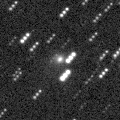
|
It became much brighter than originally expected, and reached up to 14.2 mag (Feb. 7, Artyom Novichonok). Now it is fading, but still bright as 15.6 mag (Mar. 31, Hiroshi Abe). It keeps observable in good condition in the Southern Hemisphere. In the Northern Hemisphere, it becomes observable in the evening low sky only in March and April.
Date(TT) R.A. (2000) Decl. Delta r Elong. m1 Best Time(A, h)
Apr. 9 5 48.07 -25 11.6 3.337 3.229 75 16.0 19:08 ( 97, 56)
Apr. 16 5 51.27 -22 24.9 3.455 3.262 70 16.1 18:59 ( 98, 52)
|

|
Now it is 16.0 mag (Apr. 3, M. Jaeger, E. Prosperi, S. Prosperi, W. Vollmann). It keeps 15 mag from 2011 summer to 2012 summer. But it is not observable around the perihelion. It is observable in good condition in the Northern Hemisphere in 2011, and in the Southern Hemisphere in 2012.
Date(TT) R.A. (2000) Decl. Delta r Elong. m1 Best Time(A, h)
Apr. 9 13 29.39 26 28.5 2.698 3.572 145 16.2 0:23 (180, 29)
Apr. 16 13 25.56 27 5.8 2.666 3.519 142 16.1 23:48 (180, 28)
|

|
Now it is 16.2 mag (Apr. 5, Tzec Maun Observatory). It keeps 16 mag for a while. In the Northern Hemisphere, it will be getting lower gradually after this, and it will be unobservable in July . In the Southern Hemisphere, it keeps locating low.
Date(TT) R.A. (2000) Decl. Delta r Elong. m1 Best Time(A, h)
Apr. 9 6 3.27 37 22.9 2.319 2.234 72 16.2 19:08 (154, 11)
Apr. 16 6 17.56 37 5.3 2.375 2.218 68 16.1 18:59 (153, 11)
|
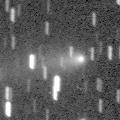
|
It reached up to 14.0 mag and became visible visually in December (Dec. 17, Juan Jose Gonzalez). Then it has been fading, and faded down to 18.3 mag on Mar. 31 (Yasukazu Ikari). However, it brightened up to 16.1 mag in outburst on Apr. 5 (J. Bel). It locates low in the Southern Hemisphere.
Date(TT) R.A. (2000) Decl. Delta r Elong. m1 Best Time(A, h)
Apr. 9 7 6.93 42 36.8 2.445 2.555 84 16.2 19:08 (167, 11)
Apr. 16 7 18.53 42 6.6 2.552 2.583 80 16.5 18:59 (166, 11)
|

|
It had been bright as 13-14 mag for a long time from 2007 to 2009. Now it is fading slowly, but it is still bright as 15.6 mag (Apr. 3, Y. Plyachshenko). It is observable in good condition in the Northern Hemisphere. It locates low in the Southern Hemisphere.
Date(TT) R.A. (2000) Decl. Delta r Elong. m1 Best Time(A, h)
Apr. 9 10 52.59 42 34.2 9.239 9.796 121 16.3 21:43 (180, 12)
Apr. 16 10 48.46 42 26.3 9.360 9.832 115 16.3 21:11 (180, 13)
|

|
Now it is 17.7 mag (Mar. 7, W. Hasubick). It was observed around 16 mag in 2009 and 2010. In 2011, it keeps observable at 17 mag from spring to autumn. It locates somewhat low in the Northern Hemisphere.
Date(TT) R.A. (2000) Decl. Delta r Elong. m1 Best Time(A, h)
Apr. 9 17 41.11 -22 45.9 3.566 4.064 112 16.9 4:34 (180, 78)
Apr. 16 17 41.40 -22 51.9 3.480 4.072 119 16.9 4:07 (180, 78)
|

|
It is expected to be bright as 9 mag from 2012 to 2013. Now it is 16.7 mag (Mar. 23, E. Bryssinck). In the Northern Hemisphere, it keeps observable in good condition for a long time until 2012 autumn when the comet brightens up to 10 mag. In the Southern Hemisphere, it is hardly observble before the perihelion passage. But it becomes observable in good condition since 2013 after the perihelion passage.
Date(TT) R.A. (2000) Decl. Delta r Elong. m1 Best Time(A, h)
Apr. 9 11 57.46 67 20.2 6.547 6.863 104 16.9 22:47 (180,-12)
Apr. 16 11 50.91 67 6.4 6.550 6.809 100 16.9 22:13 (180,-12)
|

|
It was observed as bright as 13.0 mag in last autumn (Sept. 25, Ken-ichi Kadota). Now it is fading. It has already faded down to 17.1 mag (Apr. 3, C. Bell). It will be fainter than 18 mag in May.
Date(TT) R.A. (2000) Decl. Delta r Elong. m1 Best Time(A, h)
Apr. 9 12 41.39 -24 51.8 1.990 2.956 161 17.0 23:31 (180, 80)
Apr. 16 12 35.36 -23 43.7 2.036 2.999 160 17.2 22:58 (180, 79)
|

|
Now it is 16.8 mag (Apr. 1, Tzec Maun Observatory). In the Northern Hemisphere, it keeps observable at 17 mag in good condition until summer. It locates low in the Southern Hemisphere.
Date(TT) R.A. (2000) Decl. Delta r Elong. m1 Best Time(A, h)
Apr. 9 17 48.46 32 5.1 3.713 4.053 102 17.0 4:42 (180, 23)
Apr. 16 17 39.15 34 7.2 3.656 4.069 107 17.0 4:05 (180, 21)
|

|
It is expected to keep 14-15 mag for a long time from 2011 summer to 2012 summer. The condition is good in the Southern Hemisphere, and it keeps observable for a long time. In the Northern Hemisphere, it is observable in the low sky in 2011 spring. But after that, it is not observable until 2012 August. However, this comet was observed only during two days in 2010 June. So the orbital elements are extremely uncertain.
Date(TT) R.A. (2000) Decl. Delta r Elong. m1 Best Time(A, h)
Apr. 9 18 33.02 -27 44.2 3.662 3.981 101 17.3 4:54 (226, 80)
Apr. 16 18 33.25 -28 55.6 3.496 3.925 108 17.2 4:59 (180, 84)
|
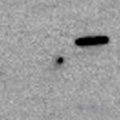
|
Now it is 17.6 mag (Apr. 6, J. F. Soulier). It brightens up to 12 mag in autumn. But the condition is bad. In the Northern Hemisphere, the altitude will be lower than 20 degree in June when it brightens up to 15 mag, then it will be unobservable in August. After the perihelion passage, it is only observable from December to February in the evening very low sky. In the Southern Hemisphere, it keeps observable for a long time, although it keeps locating extremely low.
Date(TT) R.A. (2000) Decl. Delta r Elong. m1 Best Time(A, h)
Apr. 9 8 43.85 32 28.7 1.977 2.444 105 17.6 19:35 (180, 23)
Apr. 16 8 43.93 31 56.6 2.013 2.387 99 17.5 19:07 (180, 23)
|
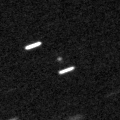
|
Now it is 17.4 mag (Apr. 2, M. Jaeger, E. Prosperi, S. Prosperi, W. Vollmann). It will brighten up to 13 mag in next winter. But the condition of this apparition is bad, and it will not be observable around the perihelion passage. It will be observable until July when it brightens up to 16 mag in the Northern Hemisphere, or until September when it brightens up to 15 mag in the Southern Hemisphere.
Date(TT) R.A. (2000) Decl. Delta r Elong. m1 Best Time(A, h)
Apr. 9 10 22.67 23 49.6 1.895 2.642 128 17.5 21:13 (180, 31)
Apr. 16 10 19.69 23 32.2 1.931 2.603 121 17.5 20:43 (180, 32)
|
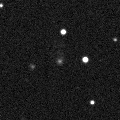
|
Now it is 17.5 mag (Apr. 1, Tzec Maun Observatory). It is fading slowly. In the Northern Hemisphere, it keeps observable in good condition until 2011 summer. It is not observable in the Southern Hemisphere.
Date(TT) R.A. (2000) Decl. Delta r Elong. m1 Best Time(A, h)
Apr. 9 17 26.24 47 28.5 5.252 5.536 101 17.6 4:19 (180, 8)
Apr. 16 17 20.66 47 51.3 5.238 5.562 103 17.6 3:46 (180, 7)
|

|
Now it is 18.7 mag (Apr. 7, J. F. Soulier). It will brighten up to 16 mag from summer to autumn, and will be observable in good condition.
Date(TT) R.A. (2000) Decl. Delta r Elong. m1 Best Time(A, h)
Apr. 9 16 38.62 -8 21.3 1.791 2.535 128 17.8 3:32 (180, 63)
Apr. 16 16 40.42 -7 30.5 1.699 2.503 134 17.6 3:06 (180, 63)
|

|
Now it is 17.3 mag (Apr. 6, Siding Spring Survey). It will be observable in good condition at 17.5 mag in 2011 spring in the Southern Hemisphere, and at 16.5 mag in next winter in the Northern Hemisphere.
Date(TT) R.A. (2000) Decl. Delta r Elong. m1 Best Time(A, h)
Apr. 9 14 13.86 -38 25.0 1.914 2.798 145 17.9 1:09 ( 0, 86)
Apr. 16 13 45.31 -36 36.1 1.812 2.745 153 17.7 0:13 ( 0, 88)
|

|
Now it is 17.8 mag (Apr. 6, Hidetaka Sato). It approaches to the earth down to 0.8 A.U. and brightens up to 18 mag in April. It is observable in good condition in the Southern Hemisphere, but it is not observable in the Northern Hemisphere.
Date(TT) R.A. (2000) Decl. Delta r Elong. m1 Best Time(A, h)
Apr. 9 16 27.90 -64 1.9 0.811 1.517 113 17.9 3:22 ( 0, 61)
Apr. 16 16 33.77 -72 20.9 0.828 1.522 112 17.9 3:00 ( 0, 53)
|
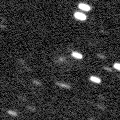
|
Now it is 16.7 mag (Feb. 16, L. Elenin and A. Novichonok). Diffuse object, but the total magnitude is bright. It keeps 17-18 mag until April.
Date(TT) R.A. (2000) Decl. Delta r Elong. m1 Best Time(A, h)
Apr. 9 14 32.93 -10 37.7 0.889 1.858 158 17.9 1:27 (180, 66)
Apr. 16 14 26.70 -10 34.2 0.901 1.893 167 18.0 0:53 (180, 66)
|

|
Now it is 17.2 mag (Mar. 5, Mt. Lemmon Survey). It tends to be brightest after the perihelion passage. At the discovery in 1999, it became brightest one year after the perihelion passage. At this time, it became brightest three months after the perihelion passage, then it is fading. It keeps observable in good condition at 18 mag until may.
Date(TT) R.A. (2000) Decl. Delta r Elong. m1 Best Time(A, h)
Apr. 9 9 53.67 9 54.0 3.144 3.848 128 17.9 20:44 (180, 45)
Apr. 16 9 53.42 9 57.5 3.245 3.866 121 18.0 20:17 (180, 45)
|
|
![]()
 C/2006 S3 ( LONEOS )
C/2006 S3 ( LONEOS ) C/2009 Y1 ( Catalina )
C/2009 Y1 ( Catalina ) 103P/Hartley 2
103P/Hartley 2 C/2010 B1 ( Cardinal )
C/2010 B1 ( Cardinal ) C/2010 X1 ( Elenin )
C/2010 X1 ( Elenin ) C/2006 W3 ( Christensen )
C/2006 W3 ( Christensen ) C/2008 FK75 ( Lemmon-Siding Spring )
C/2008 FK75 ( Lemmon-Siding Spring ) C/2010 FB87 ( WISE-Garradd )
C/2010 FB87 ( WISE-Garradd ) C/2011 A3 ( Gibbs )
C/2011 A3 ( Gibbs ) 123P/West-Hartley
123P/West-Hartley 240P/2010 P1 ( NEAT )
240P/2010 P1 ( NEAT ) C/2005 L3 ( McNaught )
C/2005 L3 ( McNaught ) 74P/Smirnova-Chernykh
74P/Smirnova-Chernykh C/2011 F1 ( LINEAR )
C/2011 F1 ( LINEAR ) 43P/Wolf-Harrington
43P/Wolf-Harrington C/2009 UG89 ( Lemmon )
C/2009 UG89 ( Lemmon ) C/2010 M1 ( Gibbs )
C/2010 M1 ( Gibbs ) 73P/Schwassmann-Wachmann 3
73P/Schwassmann-Wachmann 3 71P/Clark
71P/Clark C/2007 VO53 ( Spacewatch )
C/2007 VO53 ( Spacewatch ) 115P/Maury
115P/Maury C/2011 G1 ( McNaught )
C/2011 G1 ( McNaught ) C/2011 C3 ( Gibbs )
C/2011 C3 ( Gibbs ) P/2011 A2 ( Scotti )
P/2011 A2 ( Scotti ) 203P/2008 R4 ( Korlevic )
203P/2008 R4 ( Korlevic )![]()




























